Published
on 13
Jan 2022
|
All rights reserved.
|
|
|
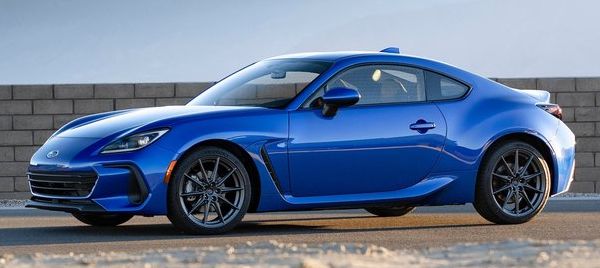
|
|
Second
generation "Toyobaru" builds on the strength of the Mk1 and irons out
its weakness.
|
|
Affordable coupes are
things of the past. Up until the late 1990s, car enthusiasts still had
plenty of affordable coupes to choose from, most notably from Japanese
manufacturers. Since then the market started shifting to hot hatches,
then SUVs and crossovers. As fewer people buy them, car makers withdrew
from this niche segment. Today, if you are young, love to have your
first taste of sports car but your budget is limited to US$30,000, your
options are pretty much limited to 3 cars: Mazda MX-5, Subaru BRZ and
Toyota GR86. And the latter two are twins. Fortunately, none of them
will disappoint.
The first generation BRZ and 86 were born almost 10 years ago as the
first joint venture between Toyota and Subaru. Basically, Subaru was
responsible for engineering and building the twins, while Toyota
injected some of its own technologies to the twins, plus designed and
tuned its version differently. That’s probably the only way to make the
business case viable under such a tough market trend against affordable
coupes. When they were launched in 2012, they got overwhelming acclaims
for handling and driver interaction, but they were also complained for
lacking power – especially low-down torque – to exploit their excellent
chassis. Predictably, market reception was quite good initially, but
then sales cooled down quickly. If judged by purely sales results, the
project would probably get no second chance. However, since Akio Toyoda
is a big sports car fan, the "Toyobaru"
sports car
twins finally gets a second incarnation.
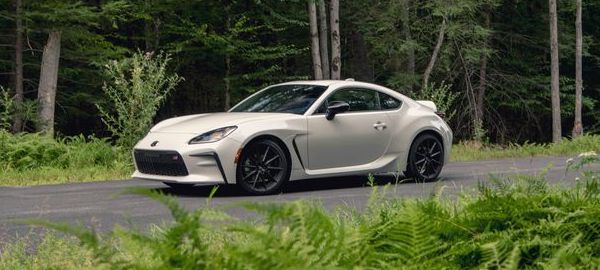
|
|
GR86
has a different nose design, but otherwise is nearly identical to BRZ.
|
|
The second generation BRZ is still called BRZ, but its Toyota sibling
has been renamed to GR86, which promotes Toyota’s new performance
label, Gazoo Racing. Otherwise, the twins still follow very much the
old formula. They are again engineered and built by Subaru with
technology inputs from Toyota (mainly its D-4S dual-mode fuel
injection), while both companies were responsible for the unique
styling
and chassis tuning of their versions. The cars’ size, mechanical layout
and market positioning remain unchanged as well. This means they should
still appeal to young enthusiastic drivers.
They are still petty compact. Measuring 4265 mm in length, they are
just 25 mm longer than the old car. Wheelbase has been stretched by
merely 5 mm to 2575 mm, while the unchanged body width of 1775 mm still
makes them highly maneuverable on twisty roads. They continue to employ
a
4-cylinder boxer engine driving the rear axle, and ride on suspensions
consisting of struts up
front and multi-link setup at the back, although Toyota calls it
“double-wishbones”. There is a Torsen LSD at the back axle, but in
order to keep cost down they offer no adaptive dampers, understandably.
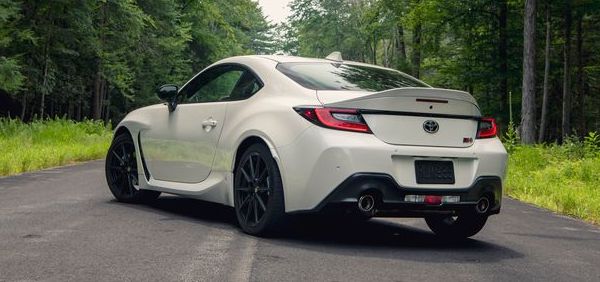
|
|
Still
a compact and light car.
|
|
Instead of electronic gadgets, the Toyobaru focused on making the
basics right. Its center of gravity is lower than that of Porsche
Cayman. Its kerb weight is tightly controlled to 1270 kg, almost
unchanged from the old car. Meanwhile, thanks to reinforcement at
various places of the monocoque, especially subframes and suspension
mounting points, torsional rigidity is lifted by a whopping 50 percent,
while front lateral stiffness gains 60 percent, both should help
handling and refinement. To offset the extra weight of the monocoque,
the roof panel and front fenders have been converted to aluminum, in
addition to the existing aluminum bonnet.
However, the most effective upgrade has to be the engine. Powering the
second generation cars is a new 2.4-liter boxer engine, still provided
by Subaru, and still naturally aspirated, as opposed to the
turbocharging mill that most rumors talked of. In the world of
turbocharging everywhere, I actually prefer to keep naturally
aspiration, whose keener throttle response and enthusiasm for rev are
great assets to a driver's car. The 2.4-liter engine keeps the 86 mm
stroke
of the old engine, but has its bore enlarged from 86 to 96 mm.
Compression ratio has been lifted from 12.5 to 13.5:1, while DVVT and
D-4S injection are kept. Output is lifted from the previous 205 hp to
228 hp SAE or 235 hp JIS, appears at the same 7000 rpm. Thanks to
oversquare combustion chambers, redline is kept at 7400 rpm, sufficient
to delight keen drivers. Most important, torque output is significantly
improved. While the old 2.0-liter motor produced only 156 lbft of
torque at a sky-high 6400 rpm, the new 2.4-liter mill supplies 184 lbft
at a far more accessible 3700 rpm. Moreover, the torque curve shows the
dip between 3500 and 4500 rpm has been greatly reduced. This should
make a huge difference in real-world drivability.

|
|
2.4-liter
engine offers a lot more mid-range grunt.
|
|
The boxer engine is again hooked up to a standard 6-speed manual
gearbox or optional 6-speed automatic. The manual-shifted car is
capable to sprint from 0-60 mph in less than 6 seconds, about a second
quicker than before. The automatic car is not only 0.8 second slower
and 24 kg heavier, but it sounds at odds to such a driver-focused car.
While the standard tires are still 215/45VR17, performance versions now
get stickier Michelin Pilot Sport 4S rubbers of 215/40VR18 to match the
increased power. Seems too narrow by today’s standards? Maybe, because
Toyobaru wants to keep the oversteering capability that made the old
cars so fun to drive.
So what separates the BRZ and GR86 ? In terms of styling, their
differences concentrate at the nose, where Toyota’s square central
intake and straight-cut side intakes show a stronger character.
Otherwise, they are pretty much identical. While the exterior design is
hardly groundbreaking, the compact, low and sleek coupe proportion is
still refreshing to eyes, especially when nowadays’ roads are filled
with blocky crossovers.
Underneath the sheet metal, their chassis tuning differs a little. The
Toyota employs slightly softer front springs and stiffer rear springs
and rear-anti-roll bar to promote more oversteering. The Subaru is set
up for higher cornering stability. To compensate the stiffer front
springs, it employs aluminum knuckles and hollow anti-roll bar at the
front suspensions, so to reduce unsprung weight and ride harshness.
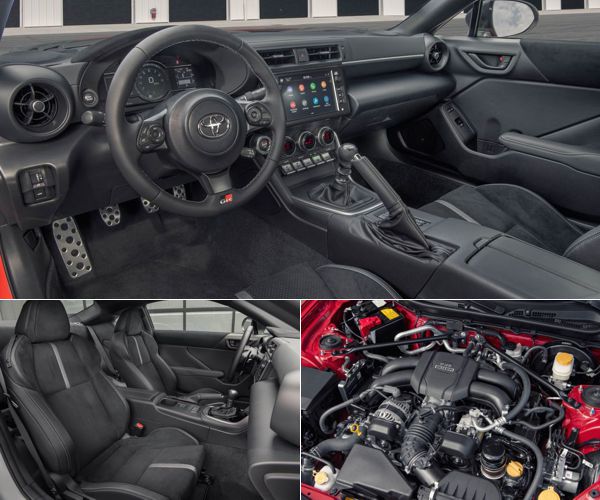 |
|
|
Interior
is improved, but still hardly a quality or desirable place.
|
|
On the Road
From the moment you get into the cabin, you will understand that the
Toyobaru is all about driving. The basics are all right: low-mounted
seats that holds you tight, small steering wheel that feels good in
hands, good all-around visibility, basic instrumentation and
touchscreen, good old physical switches for HVAC… Build quality is
improved from the old car, but still there are swaths of hard plastics
to encourage you to focus on the road ahead. Ditto the low-resolution
instrument and touchscreen, or the dark and business-like interior
design. Rear seats? You had better see them as extra luggage space,
like that of a 911.
On the roll, you are constantly reminded the lack of sound insulation
throughout the cabin. That’s a good thing, because you feel more
connected to the road. The new boxer engine feels livelier and more
responsive low-down. Power delivery is more linear. It is not terribly
quick in turbocharged era, and you
need to keep it spinning above 3000 rpm, but that is far easier to
manage than the old engine, which took 5000 rpm yet delivered far less
punch. It is quite eager at the top end, too, but not quite as willing
or as smooth as the best Honda engines. The main problem is an
uninspiring exhaust note, which lacked the off-beat burble of older
Subaru boxers, getting only more raucous at the top end.
The manual gearbox is fabulous. Shift action is slick, precise and
positive, almost as great as that of Mazda MX-5. Coupling to a light
and easily modulated clutch, gearchange cannot be more enjoyable.
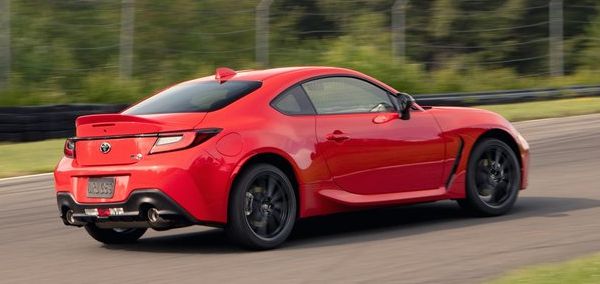
|
|
BRZ
stays closer to neutral handling and grips harder, while GR86 is keener
to turn into power sliding and feels more fun to drive.
|
|
Equally enjoyable to exploit is the chassis. Both BRZ and GR86 ride
firmly, just in a way a good old sports car is supposed to feel. They
don’t iron out rough surfaces as well as something bigger and equipped
with adaptive dampers, but still the stiffer structure provides a more
solid basis for suspension to work on. This can be seen in the quick
yet precise steering, which might lack the tactile feel of conventional
hydraulic power steering, but turns the nose into corner without
hesitation. The car’s 56:44 weight distribution is not exactly perfect,
but thanks to the careful front and rear suspension tuning, it feels
perfectly balanced in corner. Among them, the BRZ stays closer to
neutral handling and grips harder, enabling higher lateral acceleration
and slightly quicker lap time. On the other hand, the GR86 is keener to
turn into power sliding and feels more fun to drive. The Michelin 4S
tires give both cars higher cornering limit than their predecessors,
but this is well matched with the increased grunt from the engine, so
the beautiful balance is maintained.
Among all small sports cars currently on sale, only Alpine A110 and
Mazda MX-5 could be more fun to drive. The mid-engined Alpine is
lighter and more agile still, but it costs almost double the price thus
is not a direct competitor. The Mazda is more compact, has more
communicative steering and, as a 2-seat roadster, feels more special,
but the Toyobaru duo is more spacious and practical.
Uninspiring interior aside, the only obvious weakness of the duo is the
undersized brake package, which is carried over from the old cars. It
works fine in normal driving but could fade after a number of hard
stopping. However, this could be easily rectified if Brembo brake
option is offered in the future, just like the last generation did.
Just when everybody is sinking development budget into electric cars,
it is great to see the joint venture, driven mainly by the passion of
Akio Toyoda, still invested in the dying breed of affordable sports
cars. The new BRZ and GR86 are very well done, ironing out the major
shortfall of their predecessors on power while keeping their great
chassis balance intact. Most important, starting at under $30,000, they
are still relevant to young drivers.
|
Verdict:      |
|